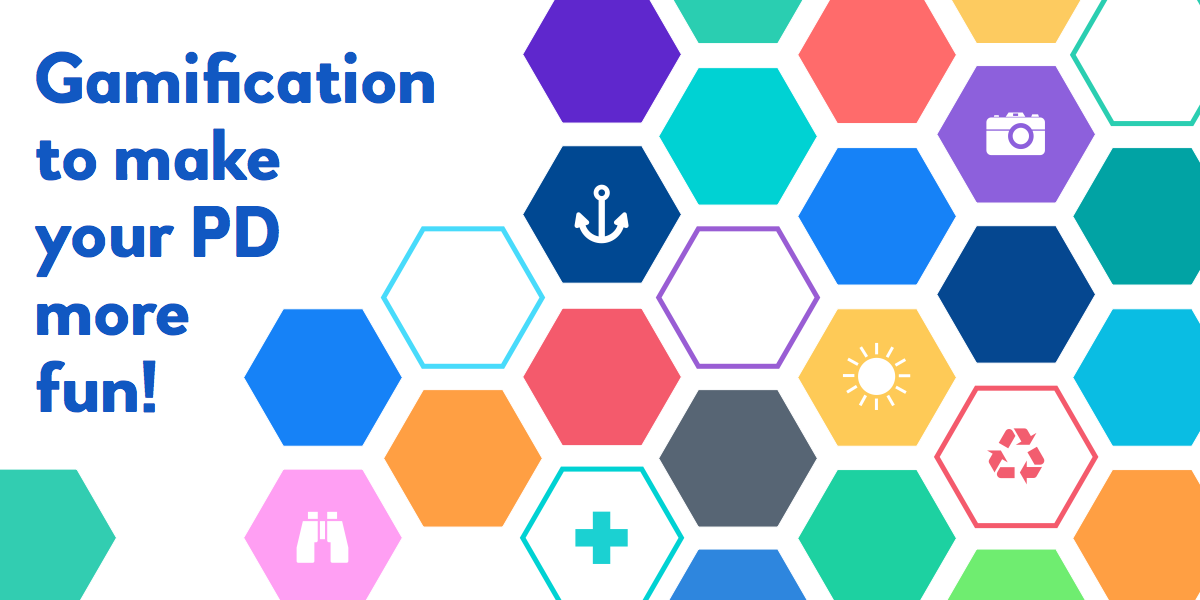


How can you bring friendly competition to your organization that supports professional learning, you ask? Lindsay Zilly, Director of Professional Learning for Illinois Digital Educators Alliance, relays how she created an environment that promotes risk-taking through gamification as a fun alternative to standard professional development.
Only have a few minutes? Watch Lindsay share the main points from her article. Then come back later to read the full thing!
What we can learn from Julia Child
I
never would’ve imagined that my gamification origin story would include cooking game shows and Julia Child. But that’s the thing about inspiration: you just never know when it will strike. Follow me down this rabbit hole and you’ll see how I got there!
When Julia Child first started out as a professional cook, she took risks and challenged norms. It was in the imperfections of her lessons that the most learning occurred. This style of playful learning broke down barriers and allowed other chefs to innovate in ways that revolutionized the cooking industry. Shows like Chopped and Master Chef embody Julia’s advice: “Learn how to cook, try new recipes, learn from your mistakes, be fearless, and above all have fun!” When I watch these kinds of shows, I see the contestants as innovators—they are handed a basket of ingredients, given a pantry of supplies, and then told to create something incredible.
Now, let’s look at this philosophy as it applies to teachers and education. Isn’t it the same? We are asked to be innovators in our classrooms; risk-takers who think outside the box and challenge norms. While in some schools it’s a slow shift from traditional practices, in others we see educators like Zack Gilbert jumping in the deep end. I recently had the pleasure of speaking with Zack, an intermediate social studies teacher at a lab school in Normal, IL, and was in awe of the shift in his practice. I asked him how he was able to reach everyone in his classroom to which he responded, “I learn their interests. Interests are based on schema and the most common connection I find amongst my students is games.”
Inspiration strikes
Armed with these ideas of playful learning from Julia Child, Zack Gilbert, and reality TV, I set out to apply them to my craft. Teachers respond well to personalized PD sessions that are authentic and relevant, so it made sense to create bite-sized opportunities for educators to learn at their own pace. Learning about something of interest to them made the experience more engaging and memorable. Gamification games made learning more fun and added an element of competition that encouraged all teachers to find a way to participate at a level they felt comfortable with.
Gamification for goals
The “Gamification for Goals” method creates opportunities for teachers to self-select a skill they’d like to develop. For example, teachers might choose to develop a deeper understanding of Apple or Google tools. As they proceed through their learning, they advance through four different levels, not necessarily starting at level one—just like a game they would play. Once they get to level four, they are asked to do something with their newly developed skills in order to earn a badge.
The goal of the badges was to make something for everyone and they were created based on teacher feedback and ongoing educational trends. Our badges are set up for ISTE standards, Twitter, cultivating a growth mindset, and many more. As the teacher levels up, they accumulate badges or stickers to put on their device. This not only encourages other teachers to see and inquire about the gamification goal process, but it also creates teacher leaders that educators can turn to for assistance.
Putting teachers at the center
The idea never would have taken root if teachers weren’t at the center of it. Some of the badges were designed by teachers, but all were created from feedback received from everyone. The result: teachers’ computers were filling up with stickers! Teachers were sharing new learning experiences with each other, going into one another’s classroom to observe their learning in action, and teachers who normally felt nervous to take risks were sharing out at staff meetings. The gamification goals process was a success and it was so successful because it was designed with teachers in mind.
Soon after the development of the gamification badges, it was obvious that teachers wanted more! This led to the birth of the Will Ferrell rating scale, Jimmy Fallon Brain Breaks, and even life-sized Candyland.
Final note
Adding a gaming component to professional learning or even classroom lessons doesn’t need to be “one more thing.” It should be the way we’re learning the content, not a reward for learning it. If you are looking to try something like this in your district my advice is simple: teachers love to learn; keep them as your focal point.
Watch Lindsay’s video overview
{% video_player “embed_player” overrideable=False, type=’scriptV4′, hide_playlist=True, viral_sharing=False, embed_button=False, width=’1920′, height=’1080′, player_id=’26673310981′, style=” %}
About Our Guest Blogger
Lindsay Zilly is the Director of Professional Learning for Illinois Digital Educators Alliance (IDEA). She has a passion for creating immersive learning experiences that pique curiosity and foster a culture of innovation. Lindsay started her educational career as a fifth grade teacher, looping back and forth between a fourth- and fifth-grade classroom. After nine years in the classroom, she transitioned into the role of an instructional technology coach, where she worked for three years towards supporting educators in a K-8 district to take risks and think outside the box.
Lindsay presents locally and nationally on various topics including sketch-noting, innovative professional learning, blended learning, and more. She has a Masters Degree in Technology Education and E-Learning, is an Apple Teacher, Google Certified educator, and would consider herself a lifelong learner.
Follow Lindsay on Twitter and Instagram @iCoachLindsay!
{{cta(‘352a410e-db79-4f33-a482-d301e8041965′,’justifycenter’)}}
Stay Connected
News, articles, and tips for meeting your district's goals - delivered to your inbox.








